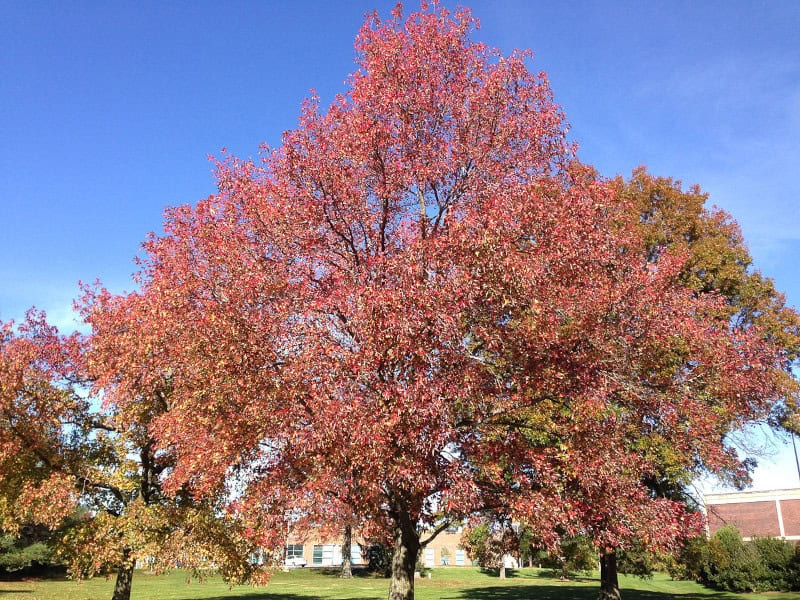
American Sweetgum Facts
- The descriptive term of American Sweetgum serves as only one of numerous common names for this intriguing variety of tree. It’s also known by such alternate terms as hazel pine, American storax, bilsted, redgum, alligatorwood, and satin-walnut, among others.
- Among scientific professionals, however, it’s better known by another moniker. Like so many such terms, though, that’s somewhat hard for the layperson to pronounce. That’s because the flora bears the technical title of the Liquidambar styraciflua.
- It received that name due to the efforts of the Swedish researcher, Carl Linnaeus. The esteemed botanist and zoologist accomplished the first acknowledgement of it as a separate and distinct species. He managed this noteworthy deed in 1753.
- Regardless of which moniker one uses, though, it remains an important species. In point of fact, it represents one of the most valuable forest trees in many portions of its range. It’s also now a highly popular ornamental tree in non-native regions of the world.
- Fortunately, the beautiful American Sweetgum appears to be maintaining a wild population base that’s both sizeable and presently relatively stable. That pleasant situation further seems to hold true throughout the entirety of its native range.
- Due to this, the IUCN presently lists it as Least Concern on its Red List. Nevertheless, it does faces certain potential threats to its existence. These naturally include habitat degradation and loss. Ongoing climate change also now represents a serious threat.
Related Articles
American Sweetgum Physical Description
The stunning American Sweetgum quickly impresses those who encounter it. It does so due to a combination of its remarkable visual appeal and its physical dimensions. The Angiosperm reaches its full potential in both regards, though, when it grows in the wild.
Depending on its location, it develops as either a mdeium-sized or large variety of tree. Specimens growing in natural conditions often attain heights measuring up to 150 ft (45 m). Those individuals in cultivation, meanwhile, rarely exceed 70 ft (20 m) in height.
A single trunk manifests in the case of this species, typically growing primarily upright. In mature specimens, this aspect of the plant achieves a diameter averaging between 2 – 3 ft (60 – 90 cm). The tree matures quickly, but often lives for up to 400 years.
Both the bark and branches present a unique appearance. The bark develops edgewise, and gives an appearance reminiscent of the scales of some reptiles. This led to the adaptation of the nickname alligatorwood. It’s also light brown, with red or gray shades.
The leaves of the American Sweetgum also merit notice. These typically develop with 5 sharply pointed lobes. Occasionally, however, these show either 3 or 7 lobes. This foliage manifests a rich, dark green hue. They also change to visually dazzling reds in the Autumn.
Its flowers usually appear in Spring, and often last until Autumn. These blooms most often measure 1 – 1.5 in (2.5 – 4 cm) in diameter. Intriguingly, these develop as greenish in color. When its fruit appears, it develops as numerous, round, and of the same size as the flowers.
- Kingdom: Plantae
- Phylum: Tracheophyta
- Class: Magnoliopsida
- Order: Saxifragales
- Family: Altingiaceae
- Genus: Liquidambar
- Species: L. styraciflua
American Sweetgum Distribution, Habitat, and Ecology
The American Sweetgum appears natively in a moderately large area of the globe. That area likely doesn’t surprise anyone though, given its name. Nonetheless, that name itself remains somewhat misleading. The majority of the species live in part of North America.
As that moniker implies, most of its range falls within the confines of the United States. More precisely, that zone of habitation consists of the eastern section of the country. Yet, scattered populations also appear in Mexico and parts of Central America.
The precise reason for this disjointed distribution remains undetermined. What is known, though, is its impressive adaptability in terms of habitat preferences. This beautiful product of evolution thrives equally well in both warm temperate regions and tropical areas.
It does, however, displays decided preferences in terms of the type of soil it likes. This Angiosperm thrives in regions of loamy, moist, acidic, sandy, well-drained, wet, clay soils. That’s pretty specific! It does not, though, tolerate drought conditions with great success.
Unlike many trees, the American Sweetgum attains pollination via the actions of the wind, rather than those of various local insect species. After falling from the tree, the fruit lies in a husk which can remain for months at a time. The winged seeds later blow away.
The wood of the tree has strong commericial uses. The resin of the tree, exuded through the bark when wounded, is used both in medicines and in chewing gum. Being high in protein, both the seeds and leaf buds themselves can be safely consumed by humans, as well.
Species Sharing Its Range
Check out our other articles on 7 Captivating Mammals of Canada, Arrow Crab, Deception Island, Monarch Butterfly, Grizzled Giant Squirrel, Southern Darwin’s Frog, Hermann’s Tortoise
